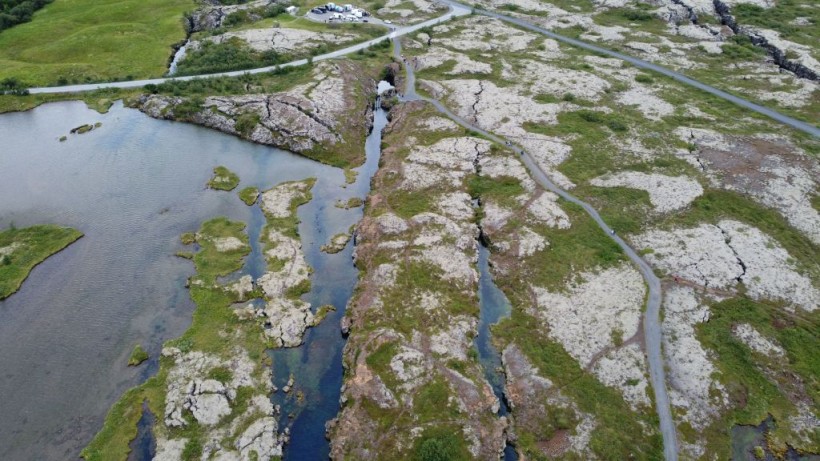Earth is the only planet in the solar system that has plate tectonics, the process of moving and recycling the outer layer of the planet, called the crust.
Plate tectonics is responsible for shaping Earth's surface, creating mountains, volcanoes, earthquakes, and continents and also influences Earth's climate, biosphere, and geochemical cycles, making it a key factor for the origin and evolution of life.
However, it is not clear when and how plate tectonics started on Earth.
Some scientists argue that plate tectonics has been operating since the early stages of Earth's history, soon after the formation of the crust.
Others suggested that plate tectonics emerged later, after a period of stagnant-lid regime when the crust was rigid and immobile.
A recent study by researchers from China, Australia, and Canada has used geochemical techniques to analyze some of Earth's oldest rocks from the Acasta Gneiss Complex in northwest Canada.
The study, published in Science Advances, revealed how these rocks can provide insights into the presence or absence of plate tectonics 4 billion years ago.
How to detect plate tectonics in ancient rocks
 (Photo : JEREMIE RICHARD/AFP via Getty Images)
(Photo : JEREMIE RICHARD/AFP via Getty Images)

Plate tectonics involves the recycling of surface materials into the mantle, the layer below the crust. This recycling occurs mainly through subduction, the process of one plate sinking beneath another at convergent boundaries, as per Phys.org.
Subduction brings hydrated crustal materials into the mantle, where they can be partially melted and incorporated into magmas that rise to form new crust.
One way to detect the recycling of surface materials into magma is to measure their isotopic compositions.
Isotopes are atoms of the same element that have different numbers of neutrons and thus different masses.
Different isotopes of an element can have different behaviors and distributions in nature, depending on various factors such as temperature, pressure, and chemical reactions.
The researchers focused on two elements that are abundant in crustal rocks: silicon (Si) and oxygen (O). These elements have three stable isotopes each: Si-28, Si-29, and Si-30 for silicon; and O-16, O-17, and O-18 for oxygen.
The researchers measured the ratios of these isotopes in zircon crystals from ancient granitic rocks from the Acasta Gneiss Complex.
Zircon is a mineral that contains traces of uranium and thorium, which decay over time and allow dating the age of the crystals. It is also resistant to weathering and alteration, which makes it a reliable recorder of the original isotopic signatures of the magmas from which it crystallized.
The researchers used ultra-high precision analytical techniques to measure the Si and O isotopes in zircon crystals from rocks that range in age from 4.0 to 3.6 billion years old.
They compared these results with data from other ancient rocks from around the world.
Also Read: Climate Change and Plate Tectonics Shaped Evolution of Modern Birds, Researchers Say
What ancient rocks reveal about early tectonics
The researchers found that the oldest rocks from the Acasta Gneiss Complex (4.0 billion years old) showed no evidence of surface material recycling in their Si and O isotopes, as per ScienceDaily.
This means that these rocks were derived from magmas that did not incorporate any hydrated crustal materials from subduction zones.
However, the researchers also found that younger rocks from the Acasta Gneiss Complex (3.8 billion years old) showed evidence of surface material recycling in their Si isotopes.
This means that these rocks were derived from magmas that did incorporate hydrated crustal materials from subduction zones.
The researchers explained this difference by proposing that Earth's geodynamic regime changed between 4.0 and 3.8 billion years ago, from a stagnant-lid regime to a mobile-lid regime with plate tectonics.
They suggested that this change was triggered by a gradual cooling of Earth's mantle, which increased its viscosity and enabled subduction to occur.
The researchers also compared their results with data from other ancient rocks from around the world.
They found that widespread evidence for surface material recycling in magmas appeared 3.8 billion years ago, marking the earliest record of plate tectonics on Earth.
Implications and future directions
The study by the Chinese, Australian, and Canadian researchers is one of the first to use Si and O isotopes to trace the recycling of surface materials in Earth's oldest rocks.
It shows that these isotopes can provide valuable information on the geodynamic conditions and processes that operated on early Earth, and also shows that plate tectonics emerged later than previously thought, after a period of stagnant-lid regime.
The study has implications for understanding the origin and evolution of Earth and life. It can help to constrain the timing and mode of crustal formation and differentiation, as well as the geochemical cycles of elements and nutrients.
It can also help to explore the effects of plate tectonics on Earth's climate, biosphere, and habitability.
The researchers plan to further investigate the causes and consequences of the geodynamic transition from stagnant-lid to mobile-lid regime on early Earth.
They hope to collect more samples from different regions and ages of ancient rocks to test the generality and robustness of their findings.
They also aim to measure other aspects of geochemistry and geophysics, such as trace elements, radiogenic isotopes, and seismic tomography, to explore how they relate to Si and O isotopes and geodynamics.
Related article: Tectonic Plates Are Moving Faster as Earth Ages
© 2024 NatureWorldNews.com All rights reserved. Do not reproduce without permission.




![Roundworms with Short Memories 'Stop Forgetting' When Frozen or Given Lithium [Study]](https://1471793142.rsc.cdn77.org/data/thumbs/full/70295/280/157/50/40/roundworms-with-short-memories-stop-forgetting-when-frozen-or-given-lithium-study.jpg)
